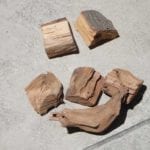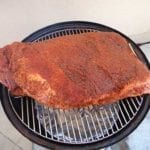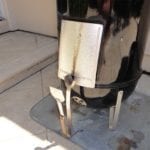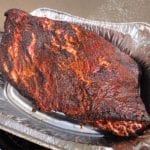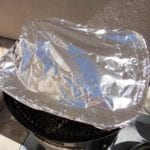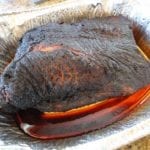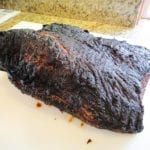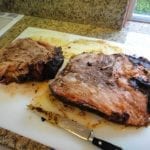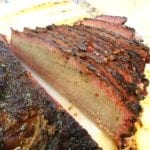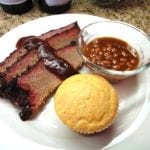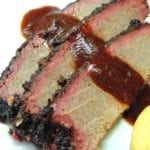Summary
- Buy a whole, untrimmed 10-12 pound USDA Choice packer brisket.
- Trim fat at the seam between the point and flat sections. Trim the fat side to about 1/4″ thick.
- Apply your favorite rub and refrigerate overnight.
- Cook the brisket fat-side down at 325-375°F for 2 to 2-1/2 hours to an internal temperature of 170°F.
- Wrap in foil fat-side up and cook another 2 to 2-1/2 hours until fork tender.
- Rest in foil for 30 minutes before slicing.
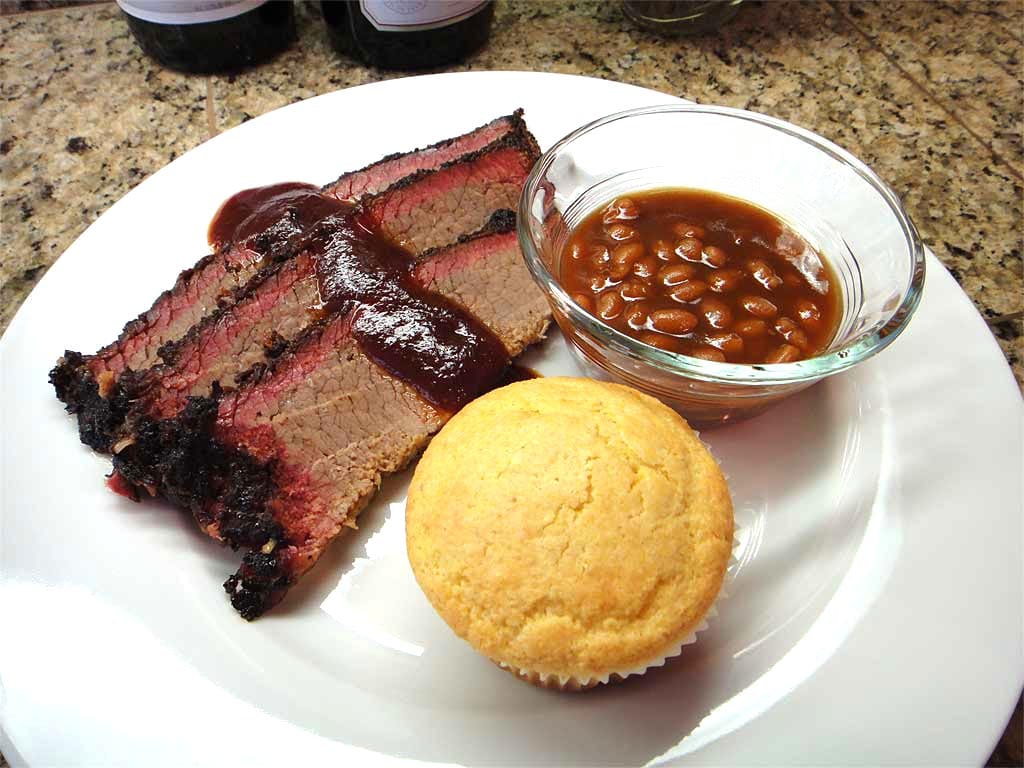 Tradition says that brisket must be cooked “low & slow” for many hours—often overnight—to achieve moist, tender meat. However, a growing number of people say that you can get the same or better results by cooking brisket at high temperature in a fraction of the time. Depending on the size and weight of the brisket, they do in 4-5 hours what most people spend 12-14 hours doing.
Tradition says that brisket must be cooked “low & slow” for many hours—often overnight—to achieve moist, tender meat. However, a growing number of people say that you can get the same or better results by cooking brisket at high temperature in a fraction of the time. Depending on the size and weight of the brisket, they do in 4-5 hours what most people spend 12-14 hours doing.
This “high-heat” method means you can cook brisket almost anytime the mood strikes you. No longer do you have to plan a long overnight cook. You can buy a brisket at 10:00am, start cooking it around noon, and have it ready for dinner at 5:00pm. This method also means you can cook brisket more often, allowing you to experiment with pastes, rubs, sauces and cooking methods more easily.
Here’s a description and photos of how I cooked this high-heat brisket on July 3, 2010.
Select & Trim The Brisket
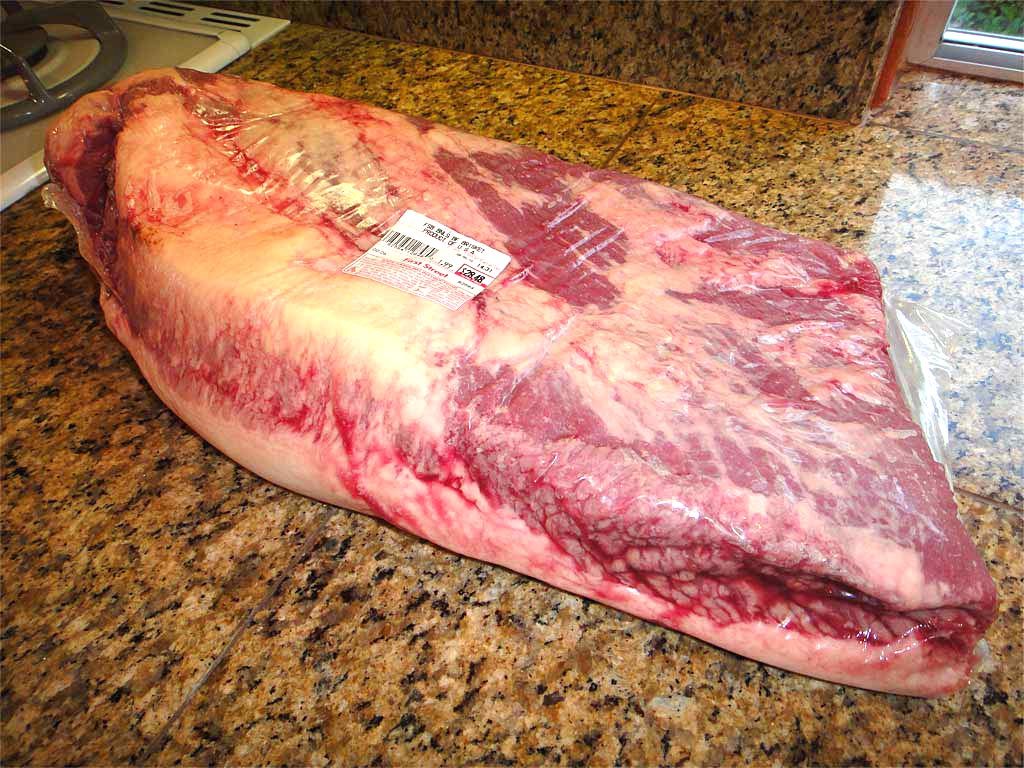 Choose a whole, untrimmed 10-12 pound USDA Choice packer brisket in Cryovac packaging. This brisket weighed 14 pounds. I couldn’t find a smaller one the day I went shopping, but it worked just fine and only took a little longer to cook.
Choose a whole, untrimmed 10-12 pound USDA Choice packer brisket in Cryovac packaging. This brisket weighed 14 pounds. I couldn’t find a smaller one the day I went shopping, but it worked just fine and only took a little longer to cook.
Turn the brisket fat-side down and trim some of the excess fat from the seam between the point and flat sections. This photo shows how I trimmed the fat so it was flush with the surrounding area. You can be more aggressive about removing fat from this seam, if you wish.
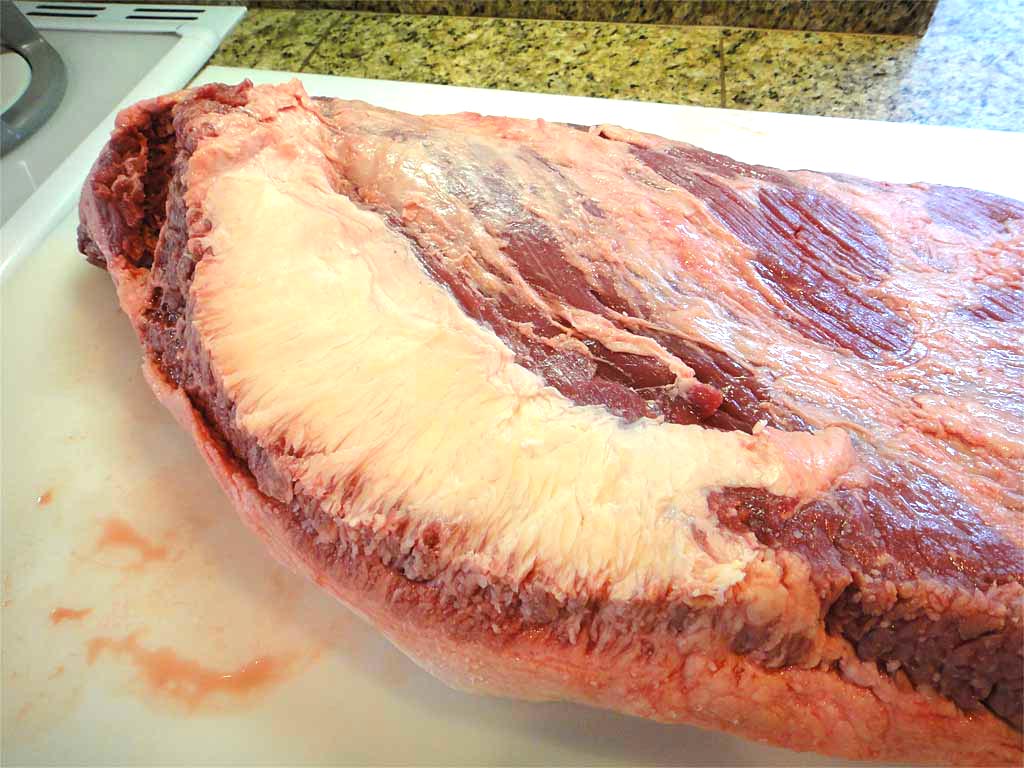
Turn the brisket fat-side up and trim the thickest areas of fat to about 1/4″ thick.
Learn more later: Brisket Selection & Preparation
Rub The Brisket
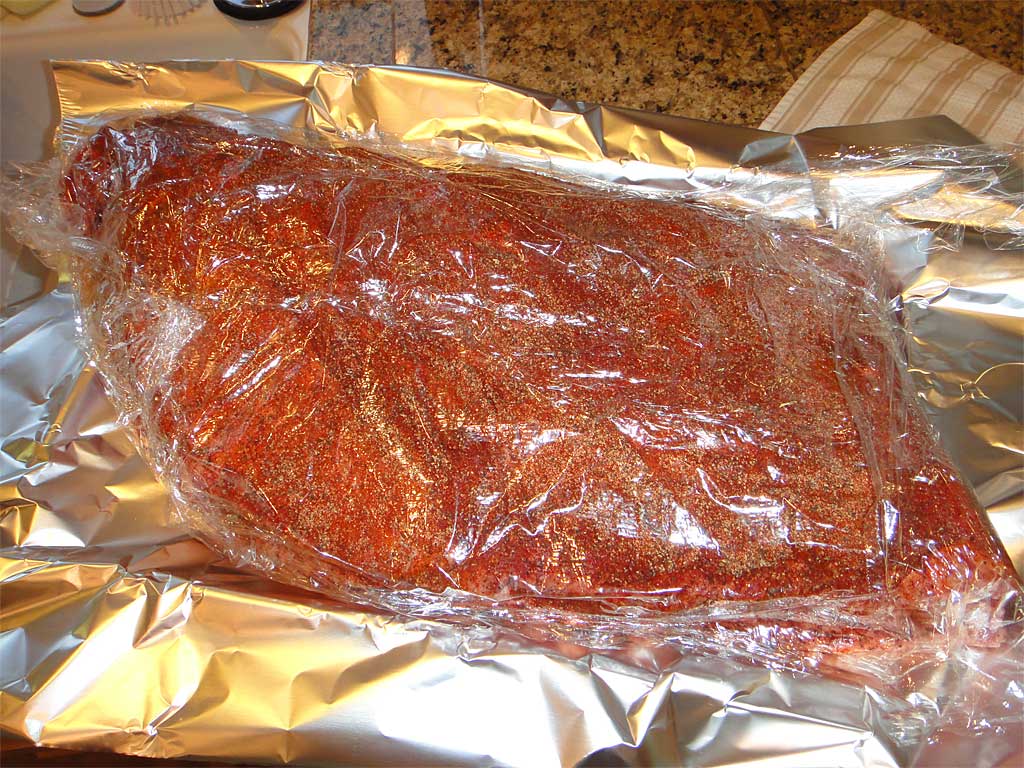
Apply a generous amount of your favorite rub to the brisket, wrap in plastic wrap or place in a 2-gallon Ziploc bag, and refrigerate overnight.
If you don’t have a favorite rub, try this one from Weber’s Charcoal Grilling: The Art of Cooking with Live Fire that I modified by deleting the sugar—I figured it would burn during the high-heat cook.
Jim’s All-Night Brisket Rub
2 Tablespoons granulated sugar- 2 Tablespoons ground black pepper
- 2 Tablespoons sweet paprika
- 2 Tablespoons pure chili pepper powder (e.g. ancho)
- 2 teaspoons onion salt
- 2 teaspoons garlic salt
- 2 teaspoons celery salt
- 2 teaspoons seasoning salt
“Pure chili pepper powder” refers to a single variety of chili like ancho or chipotle that has been ground into a powder. It should not be confused with common “chili powder” that contains a mixture of peppers, cumin, garlic, oregano, and other spices.
Fire The WSM
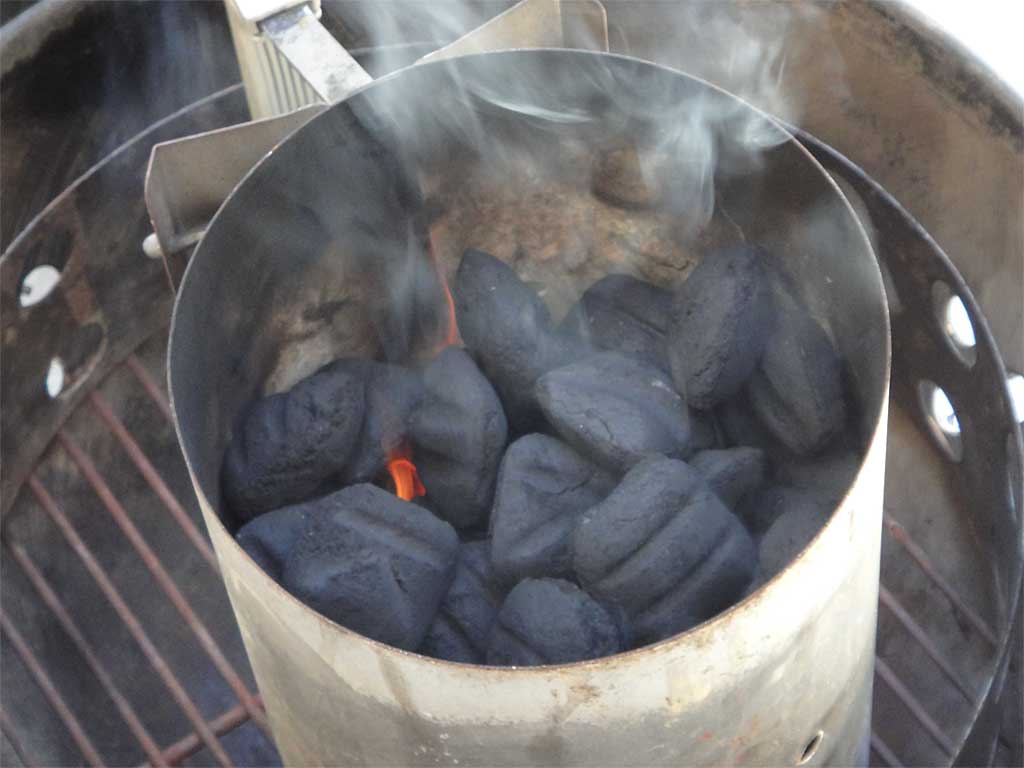
Fill the charcoal chamber to the top with unlit Kingsford Charcoal Briquets. Fill a Weber chimney starter about 3/4 full with charcoal (about 75 briquettes). Light the charcoal and then spread the hot coals over the unlit ones.
Foil the inside of the water pan, then line with a second sheet of foil suspended about 1″ above the bottom of pan. This air space helps prevent the brisket drippings from burning during the high-heat cook.
Learn more later: Firing Up Your Weber Bullet
High-Heat Barbecue The Brisket
Place 6 medium-sized chunks of dry smoke wood on the hot coals. I used 2 hickory wood chunks and 4 apple wood chunks.
Assemble the cooker with the empty, foiled water pan in place.
Put the brisket on the top cooking grate fat-side down and cover with the lid. The fat helps shield the brisket from the high cooking temperature. A large brisket like the 14-pound one I cooked can be shoe-horned in between the grate handles and will shrink during cooking.
Set the top vent to 100% open and leave it that way throughout the entire cooking process. Start with all 3 bottom vents 100% open. The cooker will smoke a lot during the first 45-60 minutes as the charcoal ignites and the wood chunks burn. Once the smoke begins to subside, start monitoring the cooker temperature.
For high-heat brisket, the cooker temperature should be 325-375°F measured at the lid. If necessary, turn the access door upside down and prop it open (see photo above) to allow more air into the cooker to increase cooker temperature. Open or close the door and adjust the bottom vents as needed to maintain 325-375°F throughout the remainder of the cooking process.
About 2 to 2-1/2 hours into the cooking process, check the internal temperature of the brisket. Insert an instant-read thermometer into the flat portion horizontally from the side. When it measures 170°F, place the brisket fat-side up on several sheets of wide, heavy duty aluminum foil and wrap so that the foil is sealed but allows room for liquid to accumulate inside. Better yet, use a disposable foil pan and cover with foil.
Cook for another 2 to 2-1/2 hours until the brisket is tender. Check for tenderness by inserting a fork or probe thermometer vertically into the center of the flat portion. If it goes in and out like butter, the brisket is done. If there is some resistance, reseal and cook for another 30 minutes and then check again.
The finished internal temp should be around 205°F.
Rest The Brisket Then Slice
These photos show the finished brisket coming out of the smoker. Leave it wrapped in foil and allow it to rest on the counter for at least 30 minutes before slicing.
To hold the brisket at temperature for several hours before serving, skip the 30 minute rest, wrap the foiled brisket with towels, and place in an empty cooler. This should keep the meat at a food-safe temperature of 140°F or higher for 2-3 hours.
When ready to serve, position the brisket fat-side up and separate the point section from the flat section along the fat seam. In the third photo above, the point is on the left, the flat is on the right—the point was separated and flipped over to the left. Put the point back into the smoker for more cooking to make burnt ends or freeze it and play with it another day.
Trim excess fat from the flat section and then flip it over so the pretty side is facing up. Use a sharp slicing knife or an electric knife to cut 1/4″ wide slices and serve immediately.
Use a fat separator to de-fat the meat drippings for use in your own barbecue sauce. Steve Petrone’s No. 5 Sauce from The Virtual Weber Bulletin Board is a good one that uses 1/4 cup of meat drippings.
Learn More: High-Heat Brisket Method Compilation
Members of The Virtual Weber Bulletin Board have created a compilation of the high-heat brisket method that provides more information about the process, including several variations and a helpful Q&A section. Special thanks to Steve Cutchen for spearheading this effort.
More Brisket Links On TVWB
- Brisket – Smoked & Oven Finished
- Brisket – Midnight Cook
- Brisket – Wet Rub
- Whole Brisket – Central Texas Style Butcher Paper
- Whole Brisket – Competition Trim
- Brisket Flat – Central Texas Style Butcher Paper
- Burnt Ends – Kansas City Style
- Burnt Ends – Smoky, Sticky, Sweet
- Pastrami – Dry Cured
- Quick Pastrami – Smoked Corned Beef Brisket
- Brisket Servings Calculator
- Brisket Selection & Preparation
- Separating Brisket Flat & Point
- Using An Electric Oven To Hold Brisket At Temperature
- Camp Brisket 2020 Trip Report

